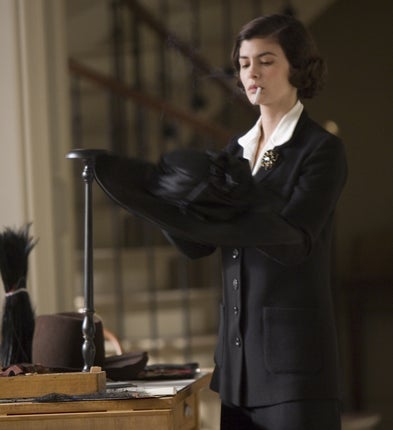Wardrobe mistress: Coco Chanel on the big screen
Audrey Tautou plays Coco Chanel in a biopic released this month – but the painstakingly-researched costumes are the real stars of the film, discovers Rosamund Witcher

Your support helps us to tell the story
From reproductive rights to climate change to Big Tech, The Independent is on the ground when the story is developing. Whether it's investigating the financials of Elon Musk's pro-Trump PAC or producing our latest documentary, 'The A Word', which shines a light on the American women fighting for reproductive rights, we know how important it is to parse out the facts from the messaging.
At such a critical moment in US history, we need reporters on the ground. Your donation allows us to keep sending journalists to speak to both sides of the story.
The Independent is trusted by Americans across the entire political spectrum. And unlike many other quality news outlets, we choose not to lock Americans out of our reporting and analysis with paywalls. We believe quality journalism should be available to everyone, paid for by those who can afford it.
Your support makes all the difference.There are fashion designers, and then there is Coco Chanel.
This month's big screen biopic, Coco Before Chanel, charts the style pioneer's rise from impoverished abandoned child to the toast of Paris, and has been eagerly awaited by anyone with even a passing interest in fashion. The film stars Audrey Tautou as the young Chanel, sewing for a tailor by day, singing cabaret by night and working to build a better life for herself, while finding her unique look and falling in love.
Chanel's story is a fascinating one, bursting with glamour and tragedy in equal measure. But it's the young designer's early wardrobe that will doubtless garner the most attention. Indeed, there can be no greater challenge for a costume designer than to dress a character acknowledged by many to be the world's most stylish woman. A fact that Catherine Leterrier knew only too well when she signed up to design the wardrobe of the young Gabrielle "Coco" Chanel.
"Of course there is pressure because Coco was the greatest," says Leterrier, who's no stranger to the world of fashion, having trained as a couturier and worked on Robert Altman's 1994 catwalk satire Prêt-à-Porter. "It is like, for an actor, when you play Shakespeare."
It helps that Tautou has the perfect combination of birdlike vulnerability and steely defiance to play the young Coco, as well as enough devil-may-care insouciance to experiment with men's hats and ties at a time when other women were trussed up in petticoats and corsets.
One of the challenges was that much of the film is set during the years when Chanel had very little money and her wardrobe would have been a far cry from the woven skirt suit and pearls that we think of as her uniform. Leterrier deals with this by showing the genesis of pieces that would go on to become classics. For example, Chanel uses a black cotton quilted sewing bag in the shape of the classic 2.55 (the famous chain strap would be added years later). And the stripy Breton top with palazzo pants is shown as being inspired by a trip to the beach, where a group of fishermen were wearing the blue and white banded top. "Coco adopted outfits that were worn by workers," explains Leterrier. "Something like the stripy shirt would never have been worn by society. So I imagined that she might have come across some sailors and interpreted their look in her own way."
Now that these pieces are such fashion staples, it's not easy to comprehend just how revolutionary Chanel's style was at the turn of the century. Practicality was the driving force behind the design of the 2.55 handbag: the long shoulder strap was inspired by soldiers' bags, and freed up women's hands. Now considered the epitome of understated chic, the handbag laughed in the face of convention at that time.
Leterrier believes part of the key to Chanel's success was her gamine beauty. "Couturiers in those days were not good-looking," she explains. "But Chanel was her own muse and she became an icon. Now all designers have a look: Marc Jacobs, John Galliano ..." One man with a definite look is Chanel's creative director Karl Lagerfeld. Although he didn't work on the designs with Leterrier, he did look through her sketches and approve Chanel's wardrobe. And most importantly, he allowed access to the label's archive so Leterrier could select vintage pieces for a fashion show scene. "That was so nice of him because I did not have to replicate the classic pieces," she smiles. "I would not have the pretension to redo them."
Like all French women, Leterrier has an ingrained sense of style. But unlike most, she received a fashion education from an early age. "My mother took me to the Christian Dior show when I was eight," she confesses. "For the French, fashion is a way of life."
Leterrier found she had free rein on deciding what the young Chanel should wear. "It is the director Anne Fontaine's first period movie," she explains, "and she didn't want to be bogged down with period details so she let me decide the look. The only thing she said is that Coco should always look different from any other person in the scene. So at the ball she wears black while everyone else is in colour." The scene is a pivotal one. These days, it's hard to imagine a little black dress being an outré option for a ball. But the image of a slinky Chanel standing out among the frothy confections that were then fashionable is a stark illustration of just how ahead of her time she was.
'Coco Before Chanel' is released on 31 July
Join our commenting forum
Join thought-provoking conversations, follow other Independent readers and see their replies
Comments